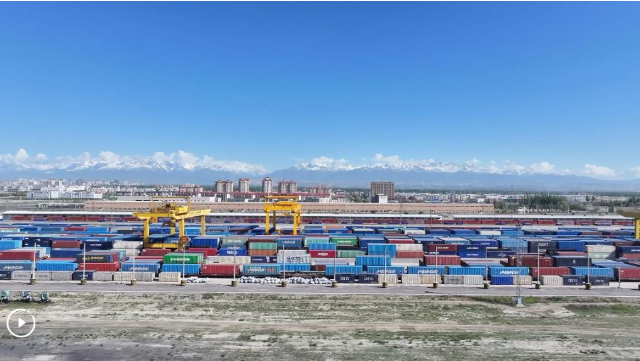Two years on, free trade zone catalyzes Xinjiang's opening up, development
来源:Xinhua 2025-11-04 16:16
*Xinjiang has broken institutional bottlenecks to drive industrial transformation and upgrading across sectors, from aviation to biomedicine.
*Xinjiang has refined cross-border supervision models in the pilot FTZ to enhance the efficiency of rail and highway transport to facilitate international trade.
*To open doors wider in the pilot FTZ, local authorities have continued to optimize the business environment by promoting personnel exchanges, improving the legal framework and aligning policies with international standards.
by Xinhua writers Wu Qiong, Zhou Shengbin
URUMQI, Nov. 3 (Xinhua) -- Established two years ago as the first of its kind in the country's northwestern border regions, China (Xinjiang) Pilot Free Trade Zone (FTZ) has turned Xinjiang Uygur Autonomous Region into a key logistics and trade hub, driving high-quality development through high-standard opening up.
By September 2025, over 18,000 new enterprises had been established in the pilot FTZ, which spans 179.66 square kilometers across three key areas -- Urumqi, Horgos and Kashgar. In the first nine months of this year, the zone contributed 40 percent to Xinjiang's total foreign trade.
The FTZ has played a leading role in promoting foreign trade, attracting investment, and fostering industrial clusters in Xinjiang, said Li Xuan, director of the Xinjiang pilot FTZ work office.

A China-Europe freight train leaves the Urumqi International Land Port Area in Urumqi, northwest China's Xinjiang Uygur Autonomous Region, May 27, 2024. (Xinhua/Wang Fei)
INSTITUTIONAL INNOVATION
Xinjiang has broken institutional bottlenecks to drive industrial transformation and upgrading across sectors, from aviation to biomedicine.
In January this year, a Georgian freighter from Tbilisi had a brake oil leakage upon landing in Urumqi. Local engineers quickly fixed the problem under an innovative "bonded maintenance" policy, including lower taxes and streamlined procedures. The plane departed smoothly the next day.
In addition to bonded maintenance, which has attracted several airlines from Kazakhstan and Uzbekistan among others, "bonded refueling" has seen more than 110,000 tonnes of cheaper fuel pumped to planes, reducing airlines' fuel costs by 13 percent, according to Urumqi Customs.
Thanks partly to policy innovation, the Urumqi airport handled 68,100 tonnes of international cargo in the first eight months of 2025, a year-on-year surge of 369.9 percent, according to official data.
In the biomedicine sector, China-Uzbekistan Belt and Road Joint Laboratory on New Drug, established in the FTZ in December 2023, has built a cross-border research and development platform, comprising six international labs across Central Asia.
A full-chain system will be created to integrate medicine research, production, clinical study and talent cultivation, which will benefit people from Belt and Road countries, said He Fei, a researcher at the laboratory.

A postal truck leaves the comprehensive bonded zone of Horgos in Horgos, northwest China's Xinjiang Uygur Autonomous Region, Sept. 11, 2025. (Xinhua/Li He)
ENHANCED LOGISTICS
Xinjiang has refined cross-border supervision models in the pilot FTZ to enhance the efficiency of rail and highway transport to facilitate international trade.
At the Horgos railway port, the implementation of the "smart port + speedy customs clearance" model has boosted traffic efficiency and cut costs for enterprises.
"Customs clearance used to take three hours, but now it's completed in just one," Yu Huan, general manager of Horgos Jinyi International Trade (Group) Co., Ltd., said. "Our goods depart in the morning and reach markets in Almaty, Kazakhstan by the afternoon."
The easier process has fueled robust growth in the company's trade volume. In the first half of this year, its trade value reached 1.4 billion U.S. dollars, far outpacing the figure for the same period last year, Yu noted.
Horgos has also emerged as China's largest land port for commercial vehicle exports, with about 780,000 vehicles shipped from November 2023 to September 2025, according to local customs. Meanwhile, the port's China-Europe freight train throughput has surged.
Moreover, refined policies regarding highway transport have eliminated secondary warehousing and port inspections, notably raising freight throughput via highway ports across Xinjiang.

This drone photo shows a view of the Kashgar Area of China (Xinjiang) Pilot Free Trade Zone, northwest China's Xinjiang Uygur Autonomous Region. (Xinhua)
HIGHER-STANDARD OPENING UP
To open doors wider in the pilot FTZ, local authorities have continued to optimize the business environment by promoting personnel exchanges, improving the legal framework and aligning policies with international standards.
In the pilot FTZ's first immigration service center in Urumqi, Russian tourist Yulia applied for a visa extension for her husband, who was diagnosed with cancer two years ago and is in China for surgery. She was surprised by the unexpectedly swift process. "Their efficiency truly moved me."
Legal safeguards have also accelerated. Fan Xuejun, who earned a master's in international law from Xinjiang University in 2017 with a focus on China-Central Asia laws, began her career at the China-Kazakhstan Horgos International Border Cooperation Center, a joint zone facilitating free trade with duty exemptions.
The cooperation model has boosted trade but also created challenges, including unclear registration procedures and jurisdictional ambiguities. To address these issues, an international legal service zone was launched in August 2024, attracting law firms specializing in foreign-related legal affairs and international arbitration institutions to offer one-stop professional services for cross-border businesses.
So far, the legal service zone has handled 105 foreign-related litigation cases and resolved 269 disputes within the China-Kazakhstan Horgos International Border Cooperation Center.
"A key witness and participant in building this system, I've seen Horgos transform from a Belt and Road logistics node into a major international trade and business center," said Fan, who is now director of Guangdong Chenggong (Urumqi) Law Firm.

Travelers from Kazakhstan enter the China-Kazakhstan Horgos International Border Cooperation Center in Horgos, northwest China's Xinjiang Uygur Autonomous Region, April 19, 2024. (Xinhua/Chen Shuo)
Kashgar, a key hub on the Belt and Road, is also forging new ground in cross-border collaboration through policy alignment of the Kashgar Economic Development Zone with Kyrgyzstan's free economic zone under a joint working mechanism.
Today, the policy alignment has delivered tangible benefits for enterprises in the two zones and enhanced cross-border connectivity.
Kashgar has established an international mail exchange office and a Transport Internationaux Routiers (TIR) hub, enabling "warehouse-to-warehouse" deliveries between China and Kyrgyzstan in 48 to 72 hours while doubling efficiency, according to Liao Hui, a local official.
In the first nine months of 2025, bilateral trade between the two sides in the zones reached 3.66 billion yuan (about 516 million U.S. dollars). The TIR hub managed 409 outbound shipments, accounting for 19.3 percent of China's total TIR traffic and ranking the top nationwide.
Going ahead, the pilot FTZ will continue deepening reforms to position itself as a driving force for Xinjiang's opening up, expanding its reach, scope and impact across wider sectors, Li Xuan said.






